- eISSN 2353-8414
- Tel.: +48 22 846 00 11 wew. 249
- E-mail: minib@ilot.lukasiewicz.gov.pl
Techno-paranoja, techno-strach oraz narcyzm jako determinanty zaufania konsumentów w stosunku do urządzeń wearables
Bogdan Gregor1, Emilian Gwiaździński2*
Uniwersytet Łódzki, Katedra Marketingu, Zakład Badań Marketingowych, ul. Jana Matejki 22/26, 90-237 Łódź, Poland
1E-mail: bogdan.gregor@uni.lodz.pl
ORCID: 0000-0003-1681-2073
2*E-mail: emilian.gwiazdzinski@uni.lodz.pl
ORCID: 0000-0002-7125-9955
DOI: 10.2478/minib-2023-0021
Abstrakt:
W dobie transformacji cyfrowej i przekształcenia tradycyjnych form komunikacji między konsumentami a markami, kolejnym kanałem kontaktu zaraz po smartfonach sukcesywnie stały się urządzenia wearables. Na podstawie studiów literaturowych oraz przeglądu dostępnych urządzeń tego typu na rynku wyodrębniono trzy kategorie urządzeń wearables: nieingerujące w ciało (np. inteligentne zegarki), pośrednie (wystające urządzenia) nakładane na ciało (np. inteligentny tatuaż, inteligentne kolczyki kolczyki) oraz ingerujące w ciało konsumenta (np. chipy podskórne, implanty na organach wewnątrz ciała lub w mózgu). Celem artykułu było dokonanie oceny poziomu zaufania do technologii wearables oraz jego determinantów takich jak poziom narcyzmu respondenta oraz obawy przed technologią na przykładzie konstruktów: techno-paranoi oraz techno-strachu wśród młodych respondentów. Okazało się, że spośród trzech badanych predyktorów tylko dwa z nich okazały się istotne (techno-strach i techno-paranoja istotnie negatywnie determinują poziom zaufania). Techno-paranoja była istotna w przypadku każdego z trzech typów technologii wearables, natomiast techno-strach tylko w przypadku technologii nieinwazyjnych.
MINIB, 2023, Vol. 50, Issue 4
DOI: 10.2478/minib-2023-0021
Str. 21-42
Opublikowano 13 grudnia 2023

Techno-paranoja, techno-strach oraz narcyzm jako determinanty zaufania konsumentów w stosunku do urządzeń wearables
Introduction
Wearables technology or wearable devices are a type of miniaturised electronic components, sensors or computers inserted into clothing or other wearable accessories (Wright & Keith, 2014). Examples of such devices on the market include smart watches, smart wristbands, smart jewellery, smart clothing, smart clips, smart contact lenses, smart specialised sensors, smart tattoos (Piątek, 2018) or even smart chips that are subcutaneous (The Economist, 2018) or implanted in the brain (Reuters, 2022). These devices are used to measure physical or physiological parameters and to make calls, read messages, record audio, video or even pay, among other things (The Economist, 2022; The Times of India, 2020).
According to estimates by Activate Consulting, the market for wearables and connected fitness equipment will reach US$28.6 billion in the United States in 2026 (Activate, 2022), while IDC predicts that there will be more than 637.1 million such devices worldwide in 2024 (Brown, 2020).
Considering the above market potential, the objective of this study was formulated, which is to identify the level of consumer trust towards wearables technology. The authors additionally assessed the relationship and its nature for selected factors, such as techno-paranoia, techno-fear and narcissism, which may determine this level of trust and examined that gender can moderate that effect.
Theoretical Context
The literature review was prepared on the basis of the SCOPUS database, for the phrases 'paranoia’, 'fear’, 'narcissism’, 'determinity’, 'wearables’ and 'trust’. Due to the different number of indications for the different configurations of the mentioned words, the authors decided to use a nested search and the expression finally had the form (TITLE-ABSKEY ((((„paranoia”) OR („fear”) OR („narcissism”) OR („determinants”)) AND („wearables”) AND („trust”)))) OR (TITLE-ABS-KEY(((„determinants”) AND („wearables”) AND („trust”)))) OR (TITLE-ABS-KEY((((„paranoia”) OR („fear”) OR („narcissism”) OR („determinants”)) AND („wearables”)))) OR (TITLE-ABS-KEY((((„paranoia”) OR („fear”) OR („narcissism”)) AND („wearables”)))). The search algorithm returned 78 results. The subsequent search narrowed the results to the following subject areas: Computer Science, Business, management and Accounting, Social Sciences, Economics, Econometrics and Finance and Psychology, and to papers in English, and 37 records were finally obtained.
The first paper was published in 2011 (Graph 1). The next one was published in 2016 (five papers), with subsequent papers published annually. Looking at the chart below, there are some fluctuations in the number of these publications from year to year, with a slight upward trend.
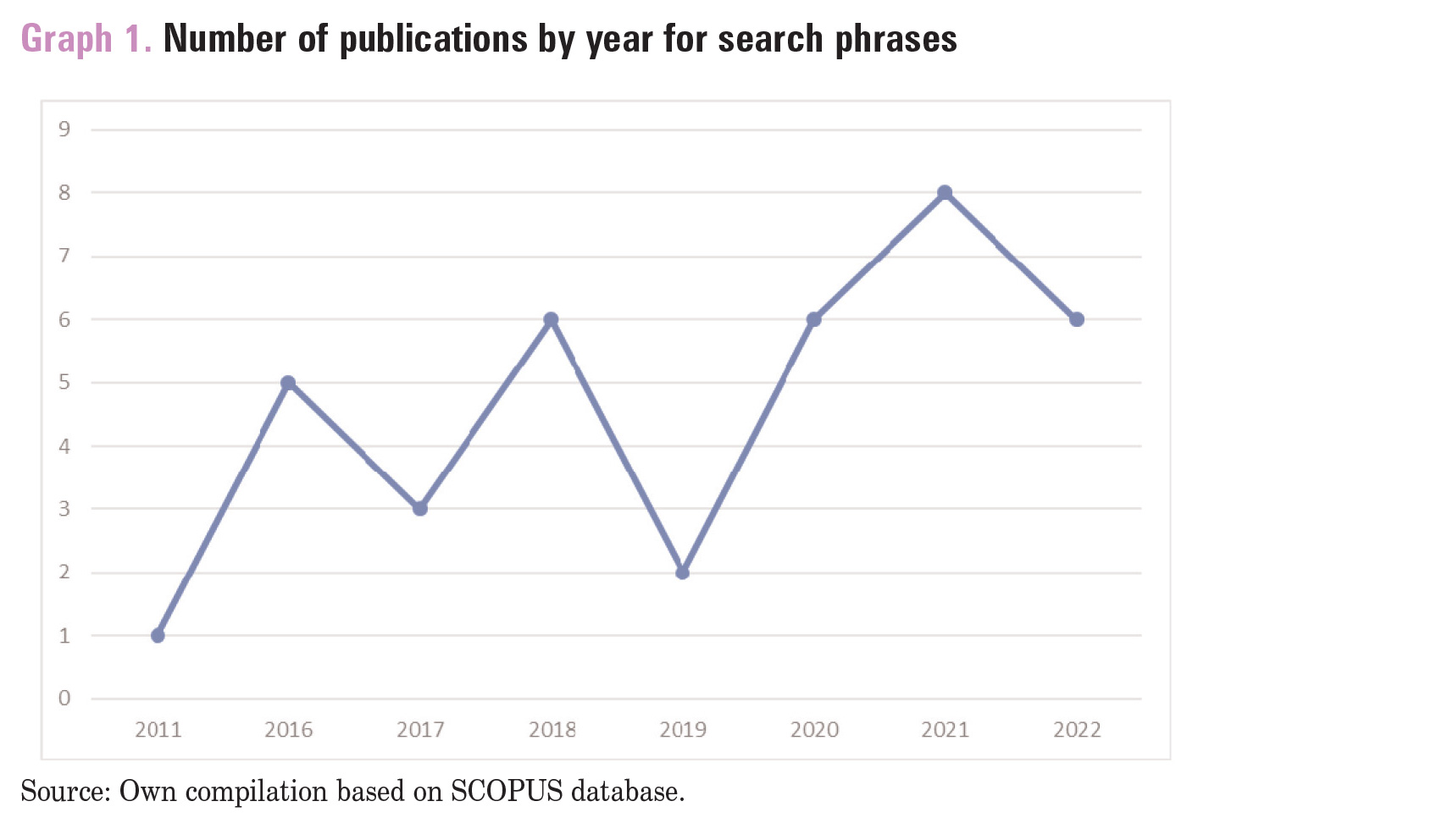

Analysing the works searched for keywords, it can be seen that the most recurring phrase was 'electronic wearables’ (Figure 1).
Other occurring keywords were 'health data’, 'fear’, 'stress’, 'tracking position’, 'technology acceptance’, 'self-concept’ or even 'technology assessment’. By categorising the keywords presented, the following groups of words can be distinguished: those relating to technology, health and sport, psychology and marketing and fashion.
In founded papers, wearables technology has been described from the perspective of determinants such as wearability, ease of use, compelling design (aesthetics as well as attractiveness), functionality, price (Karahanoglu & Erbug, 2011), technology adaptation (Al.-Emran et al., 2022; Askari et al., 2018; Nascimento et al., 2018; Pancar & Ozkan Yildirim, 2021; Schamberger & Nieroda, 2017; Sulkowski & KaczorowskaSpychalska, 2021; Wild et al., 2017), trust in technology (Gao et al., 2016), safety of use, fear, phobia or paranoia related to technology (Aksoy et al., 2020; Catherwood et al., 2015) and stress (Clusiault et al., 2022; Viegas et al., 2018).
The technology has also been described as a medium of integrity for blind and visually impaired people due to its ability to identify emotions such as fear, joy, surprise, anger, sadness and disgust based on facial expressions, and the possibility of haptic communication with users to facilitate daily life (Buimer et al., 2016). Other areas mentioned for the use of wearables were healthcare (Gao et al., 2016; Lim et al., 2019), sports (Saliba et al., 2021), in particular cycling (Kräuter et al., 2016) and climbing (Mencarini et al., 2016), psychology and psychiatry (Ortiz et al., 2017), and the technology component of the Internet of Things ecosystem (Albesher & Alhomoud, 2020).
Techno-Fear, Techno-Paranoia and Narcissism vs. Technology
Techno-fear is 'an unpleasant feeling of fear that an individual experiences in the presence of technology when it may be perceived as a threat to their existing norm’ (Khasawneh, 2018). Techno-paranoia, on the other hand, is explained as 'the unwarranted fear and distrust an individual has of technology that leads them to avoid that technology, their fear and avoidance of technology may not be supported by evidence or facts’ (Khasawneh, 2018) and 'people with paranoid behavior are suspicious’ (Von Gemmingen et al., 2003) in this case the suspicion may be about the intention of the technology and its safety. Narcissism, on the other hand, is 'a personality trait reflecting a grandiose and inflated self-image’ and is characterised by an 'unrealistic positive self-image’ (Buffardi & Campbell, 2008). Techno-fear or techno-paranoia are treated as critical determinants of modern technology acceptance and trust (Lee et al., 2018). In terms of the relationship between narcissism and technology, this relationship was addressed in the work of Rosen et al. (2013), where a team of researchers suggested that the rise of narcissism is due to advanced technology and easy access to it. Pearson and Hussain (2015), on the other hand, showed that there was a significant positive relationship between narcissism and technology addiction (using smartphones as an example), which meant that the higher the level of narcissism, the higher the propensity to become addicted to it. Based on the aforementioned, the following research questions were formulated:
- RQ1 – What differences in trust in wearables technology exist for the different types of wearables in the study group?
- RQ2 – Which of the studied predictors (techno-paranoia, techno-fear, narcissism) determine trust in particular types of wearables?
Methods
For the purposes of the study, wearables were divided into three categories: non-invasive technologies, that is, technologies that are worn on the body without interfering with it, for example, a smart watch or a smart band; indirect/emergent technologies – these are devices that interfere with the human body in some part, but are mostly on the outside, for example, a glucose sensor that is glued to the skin with a special patch while a needle is placed in the skin; invasive technologies, which are placed under the skin entirely or on internal organs.
Procedure
The survey was conducted using an online survey technique supported by an online version of the questionnaire prepared in the MS Forms software environment. The process of data acquisition lasted from November 2022 to January 2023. Individuals for the study were selected purposively, the criterion for selection being the age of the respondent. The authors focused mainly on young people, due to their possession of relatively higher technological competence in contrast to representatives of other age groups (GUS, 2020). A total of 218 respondents took part in the survey. Six questionnaires were rejected due to deficiencies and errors in the responses. Therefore, 212 questionnaires were analysed.
Research Sample
In the sample – 212 individuals – the majority were female (66%). The average age of respondents was M = 21.38 years (SD = 2.77 years); 85.9% of respondents declared their material situation to be good or average (43.9% and 42%, respectively). Only 3.3% of respondents considered their material status as very good. The rest – 10.8% considered the conditions in which they live as bad or very bad (9% and 1.9%, respectively). Slightly more than half of the respondents – 50.9% combine their studies with work, with the remainder (49.1%) declaring only studying.
Measures
Trust in wearables
Trust in wearables technology in terms of non-invasive, indirect and body-invasive was measured using a trust scale adapted from Shao et al. (2020) and Pavlou and Gefen’s (2004) work. The construct consisted of three statements – items to which respondents had to respond according to a scale from 1 to 7, where 1 meant – 'strongly disagree’ and 7 meant – 'strongly agree’. The construct was measured separately to each of the three subgroups of wearable devices.
Techno-paranoia
The scale measuring the level of techno-paranoia was borrowed from the work of Khasawneh (2018). It consisted of five items/statements (such as 'It scares me that technologies will change the way we live, communicate, love and even judge others’ or 'I am afraid of new technologies because one day it will make us (people) obsolete’), to which respondents were asked to relate on a 7-point scale, where 1 meant – 'strongly disagree’ and 7 meant – 'strongly agree’.
Techno-fear
Fear of technology was measured using a borrowed scale from the work of Khasawneh (2018). The construct consisted of five items/statements (such as 'I am afraid of new technologies because if something goes wrong with them (if they stop working for some reason), we will go back to the 'Stone Age’ or 'I am terrified of being connected to the Internet, someone might follow me.’), to which respondents referred on a proposed scale from 1 to 7, where 1 meant – 'strongly disagree’ and 7 meant – 'strongly agree’.
Narcissism
The narcissism scale (Narcissistic Personality Inventory [NPI]-13) was borrowed in a shortened version (13 items) from the work of LachowiczTabaczek and Kozłowska (2021). Respondents had to address 13 statements on a 7-item scale, where 1 meant – 'strongly disagree’ and 7 meant – 'strongly agree’.
Results
In the first part of the survey questionnaire, respondents were asked about their knowledge of both the wearable device phenomenon and the different types of wearable devices (Table 1).
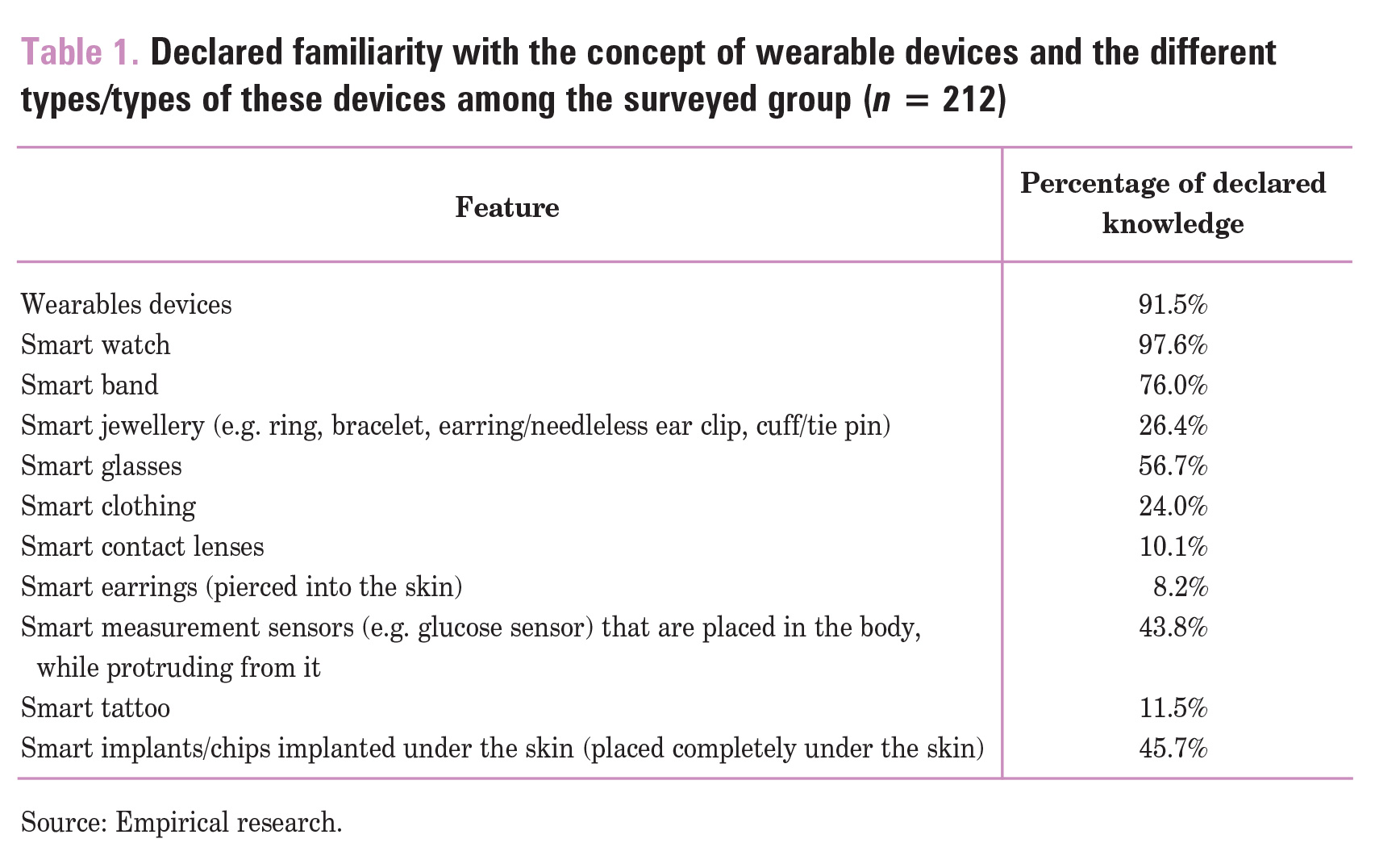
According to Table 1, 91.5% of respondents claim to be familiar with wearables. However, when it comes to the specific types of such devices, the most familiar among respondents are the smart watch (97.6%), smart wristband (76%) and smart glasses (56.7%), while the least familiar are smart earrings (embedded in the skin) (8.2%), smart contact lenses (10.1%) and smart tattoos (11.5%).
Respondents were then asked to refer to the use or declaration of future use of these devices (Table 2).
It was found that in the case of non-intrusive technologies, as many as 62.3% of respondents declared using them, while 29.7% declared a desire to use them. The remainder – 8% of respondents, neither used nor expressed a desire to use non-invasive wearables technologies.

For indirect technologies, only 4.7% of respondents declared use, 42.5% expressed willingness to use while the rest of the respondents (52.8%) did not use and declared no willingness to use. None of the respondents used invasive technologies, but more than one in five respondents (28.8%) declared a desire to use such wearables. In contrast, the remainder (more than 71%) had not used and were not willing to use such devices. It is therefore clear that the lack of willingness to use a particular type of technology is greater, as the technology’s intrusion into the body increases.
The next part of the survey asked respondents about their level of trust in different types of wearable technology. Due to the borrowing and adaptation of the trust scale for the survey, the authors performed an exploratory factor analysis (EFA) using the (PCA) method to verify its dimensionality and analysed its reliability based on Cronbach’s a coefficient. These analyses were performed for each group of wearable devices (non-invasive, indirect, invasive). The results of these analyses are presented in Table 3.
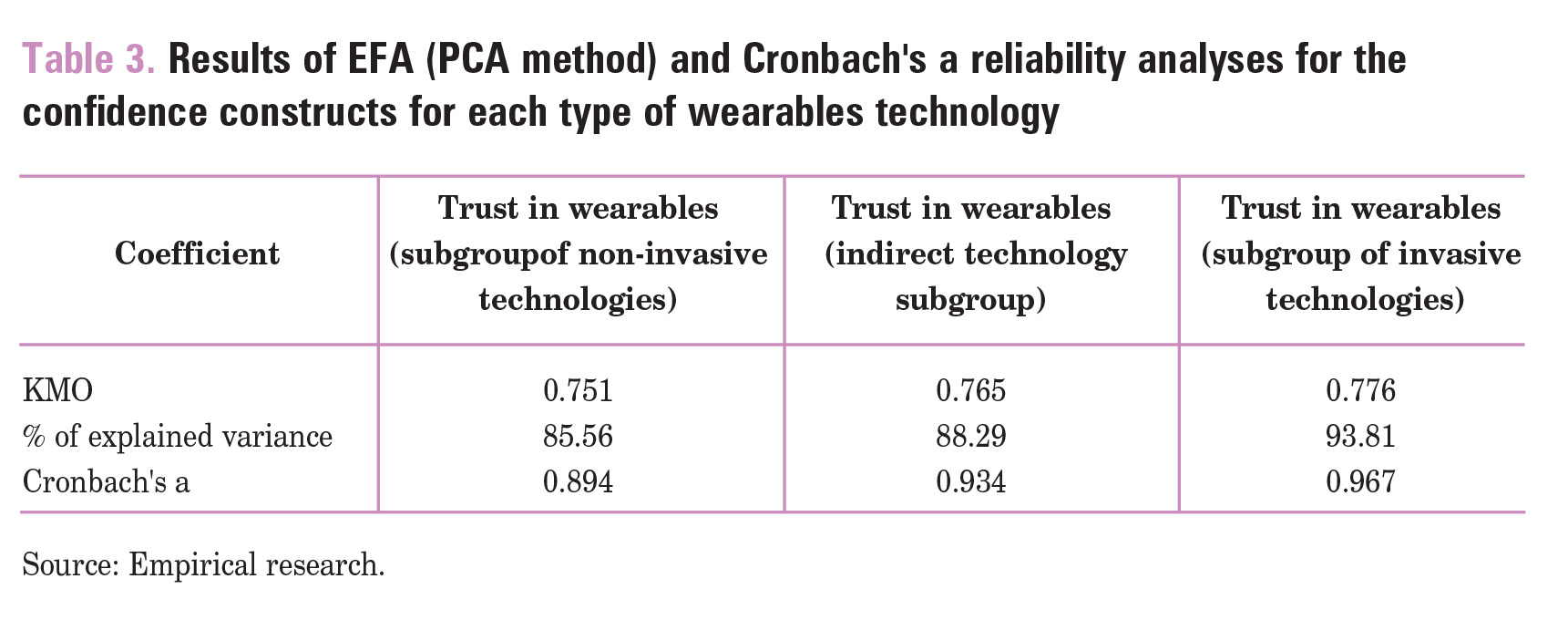
EFA, exploratory factor analysis
Based on the above results, it can be seen that the KMO measure of sampling adequacy indicates values above 0.7 da for each of the three constructs studied. A level of 0.6 is usually taken as the critical threshold from which values are considered as acceptable (Sagan, 2004). The next step, according to the Kaiser criterion, was to check the eigenvalues for the examined factors that exceed one. For each of the three examined constructs, there was only one such property – for construct one (Trust in wearables – non-invasive technology subgroup) – it explained 85.56% of the variance, for construct two (Trust in wearables – indirect technology subgroup) – it explained 88.29% of the variance and for construct three (Trust in wearables – invasive technology subgroup) – it explained 93.81% of the variance. Thus, on the basis of the EFA conducted, the unidimensionality of the scales studied was confirmed. The reliability of the tested constructs takes values above the threshold of 0.6, which is characteristic of scales with high reliability (Sagan, 2004).
In the case of the other scales, the authors borrowed them without any adaptation, so that only an analysis of their reliability was carried out. The techno-paranoia scale had a reliability of Cronbach’s α = 0.705, the techofear scale had a reliability of Cronbach’s α = 0.670 and the narcissism scale had a reliability of Cronbach’s α = 0.855.
The next step of the analysis was to identify and compare the average trust in the different types of wearable devices in the study group. The results are presented in the Graph 2.
In order to determine the significance of differences between the different types of wearables technology, a one-way ANOVA with repeated measures was performed. The analysis was preceded by verification of assumptions such as analysis of the normality of the distribution of the dependent variable in the subgroups studied (skewness and kurtosis were between 2 and –2, which are characteristic of normal distributions (George, 2011)) and sphericity as measured by the Mauchly test (the sphericity test turned out to be significant for values of p < 0.001, so the values of the F statistic were corrected based on the Greenhouse-Geisser correction). Confidence values were found to be significantly different in the subgroups studied and the effect was strong F(1,873; 395,171) = 216.295; p < 0.001, eta2 = 0.506 (main effect). Post hoc tests showed that the mean confidence in non-invasive technologies (M = 5.44; SD = 1.24) was significantly different compared with the mean confidence in indirect technologies (M = 3.99; SD = 1.42; p < 0.001) and invasive technologies (M = 3.34; SD = 1.63; p < 0.001) and between indirect and invasive technologies (p < 0.001). Thus, we found that for technologies that are more intrusive to the body, the mean confidence values are significantly lower than for non-invasive technologies.
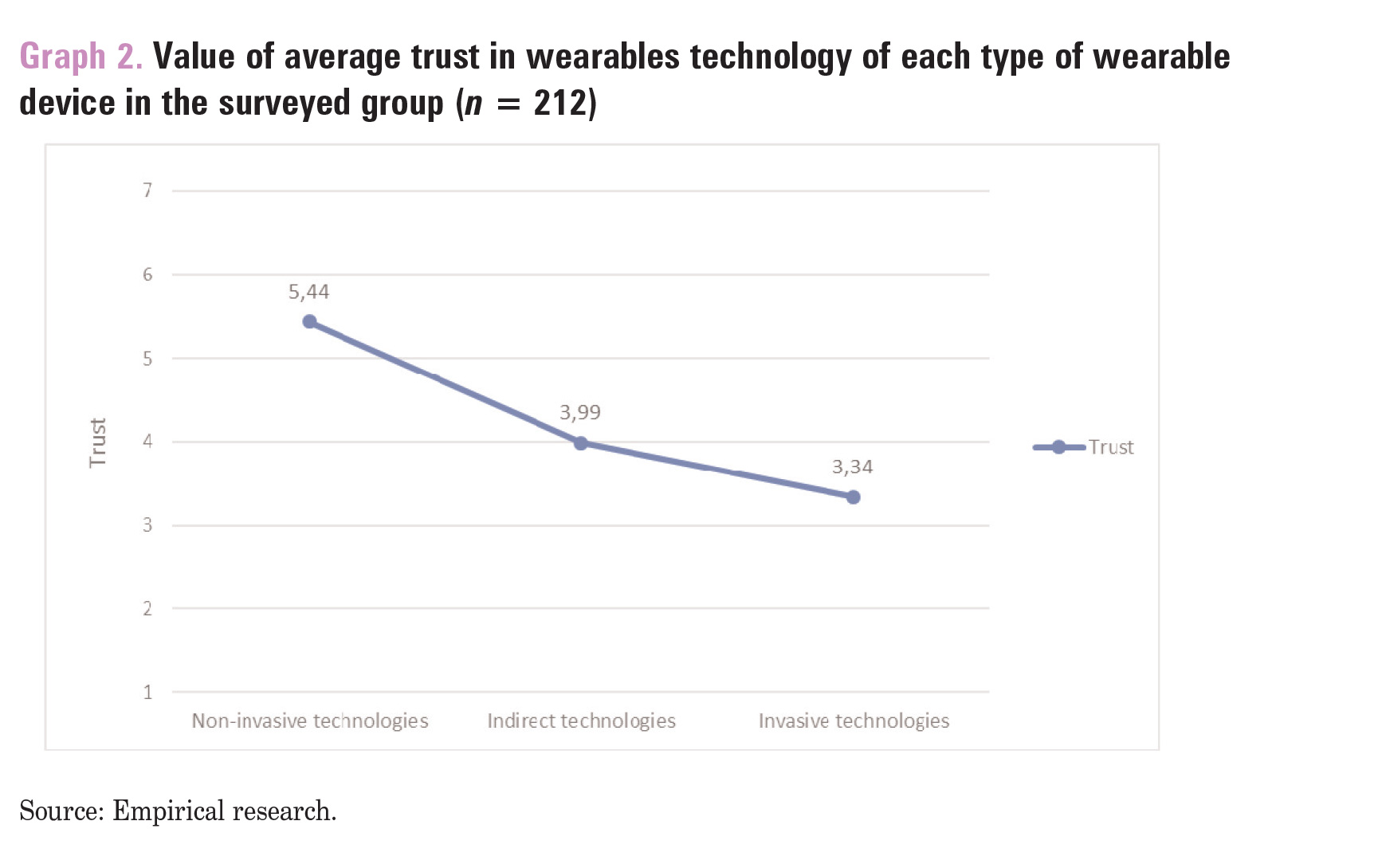
To assess which factor (techno-paranoia, techno-fear or narcissism) determines trust in each type of technology, the authors conducted a linear regression analysis. The regression analysis was preceded by verification of the normality of the distribution of the predictors based on the values of the skewness and kurtosis statistics. All values fell within the range of –2 to 2, which is characteristic of variables characterised by a distribution close to a normal distribution (George, 2011).
The first regression model was a model with a dependent variable – trust in non-invasive technologies. The result of the analysis is presented in Table 4.
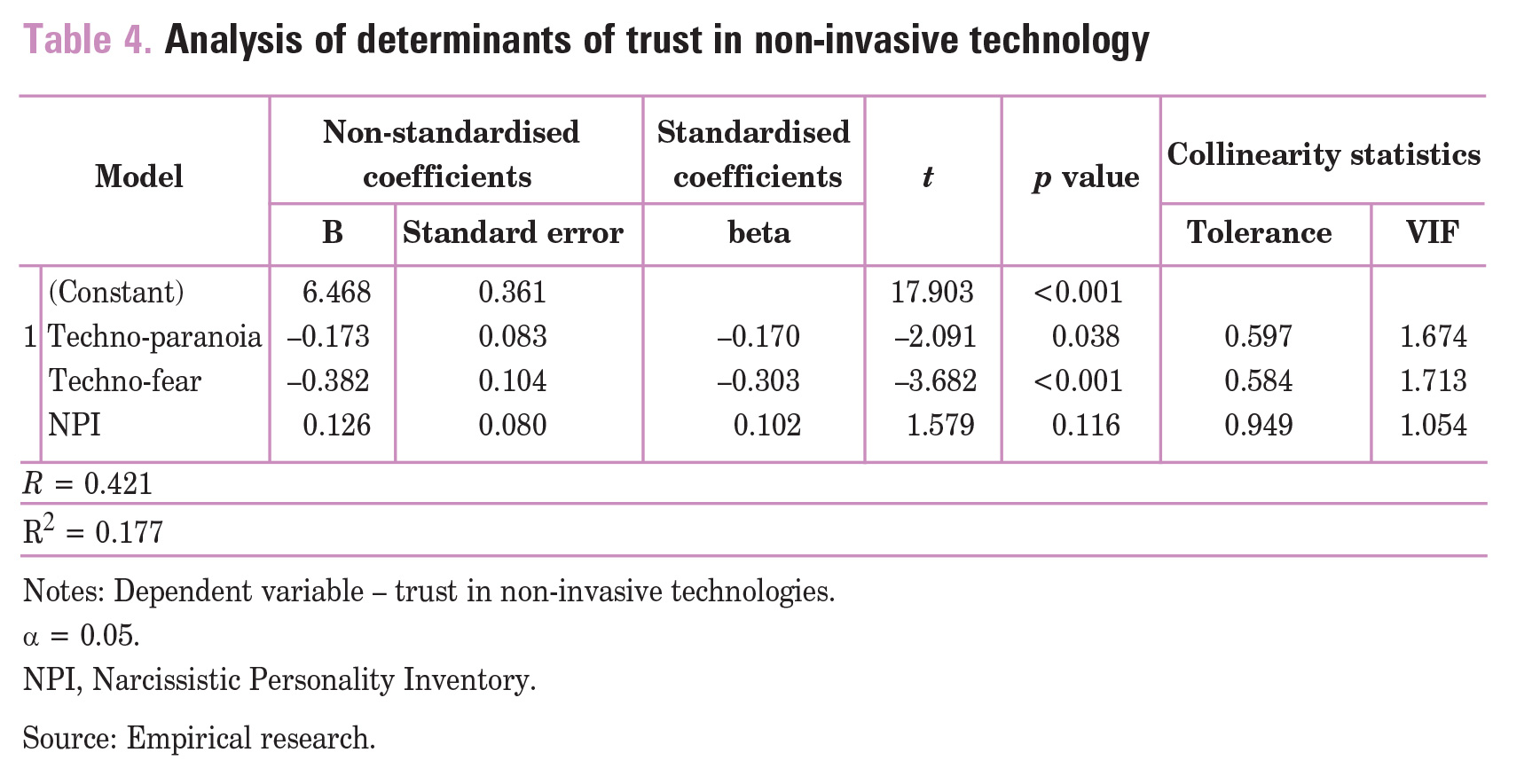
The model tested proved to be significant and a good fit to the data F(3, 208) = 14.915; p < 0.001. It turned out that in the case of trust in noninvasive technologies, the higher the trust the lower both the level of techno-paranoia (beta = –0.170; t(208) = –2.091; p = 0.038) and technofear (beta = –0.303; t(208) = –3.682; p < 0.001). Narcissism proved to be a statistically insignificant determinant t(208) = 1.579; p = 0.116.
In the next model, the dependent variable was confidence in indirect technologies (Table 5).

The model tested proved to be significant and a good fit to the data F(3, 208) = 9.207; p < 0.001. It was found that for trust in indirect technologies, the higher the trust the lower the level of techno-paranoia (beta = –0.334; t(208) = –3.964; p < 0.001). Techno-fear (t(208) = –0.238; p = 0.812) and Narcissism (t(208) = 0.665; p = 0.507) proved to be statistically insignificant determinants.
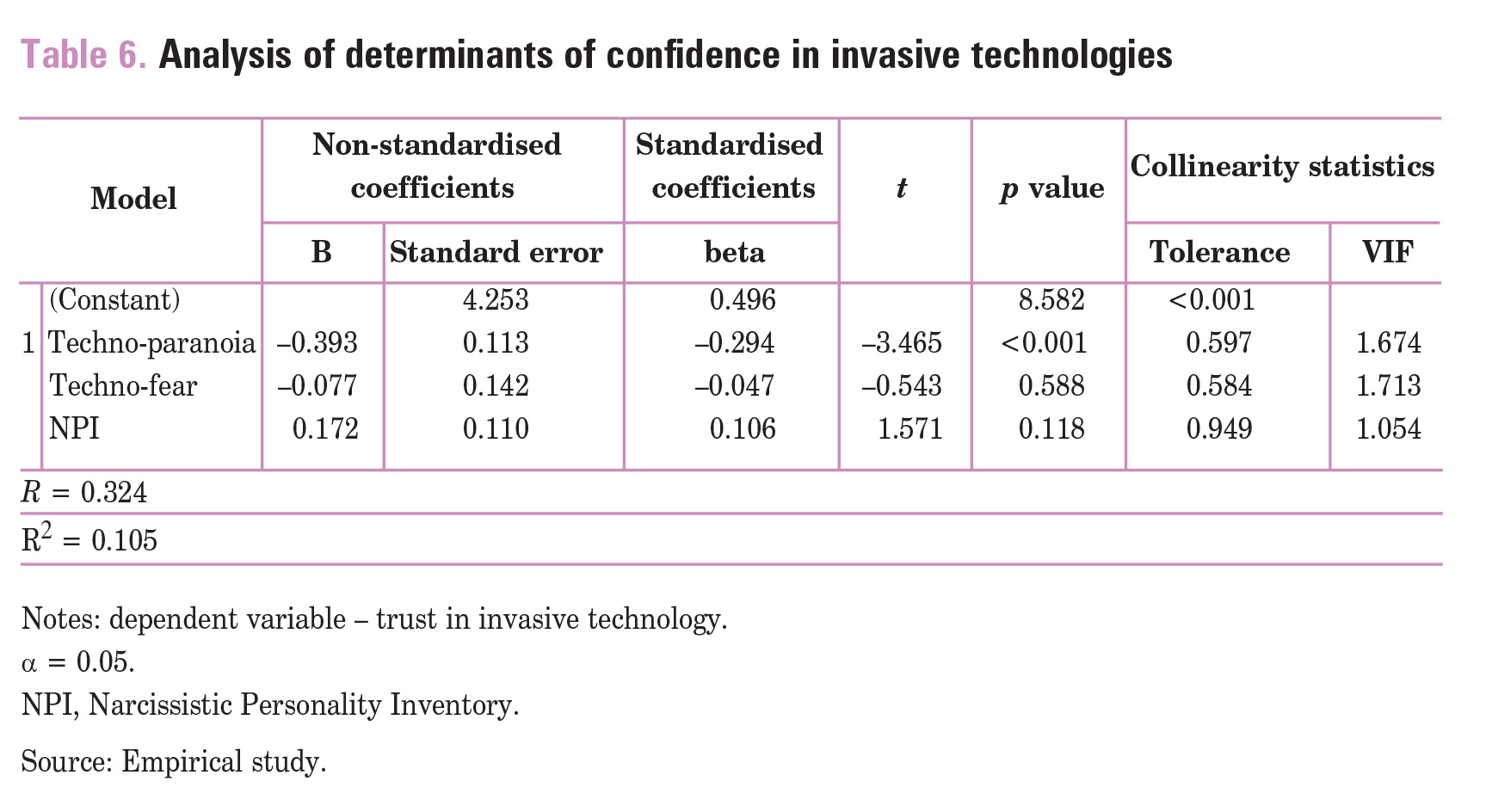
The model tested (see Table 6.) proved to be significant and well fitted to the data F(3, 208) = 8.108; p < 0.001. It was found that for trust in invasive technology, the higher the trust the lower the level of technoparanoia (beta = –0.294; t(208) = –3.964; p < 0.001). Techno-fear (t(208) = = –0.543; p = 0.588) and Narcissism (t(208) = 1.571; p = 0.118) proved to be statistically insignificant determinants.
Concentrating on the identified significant relationships between the studied determinants and trust in each of the presented forms of wearable devices, it was examined what might moderate these relationships. Most often, technology-related research examines gender differences in the context of, for example, online shopping (Awad & Ragowsky, 2008; Gefen et al., 2003; Pengnate & Sarathy, 2017), e-commerce (Fang et al., 2014; Riedl et al., 2010), virtual communities (Ridings et al., 2002; Wu et al., 2010) or mobile social networking service (Gong et al., 2015).
Moderated linear regression analysis was used to test for differences in the relationships studied. The PROCESS macro (version 4.1; model 1; Hayes, 2022) was used. A significant interaction effect between gender and techno-paranoia on trust in non-invasive devices was observed (b = 0.295, SE = 0.1421, t = 2.078, p < 0.05, LLCI = 0.015, ULCI = 0.576).
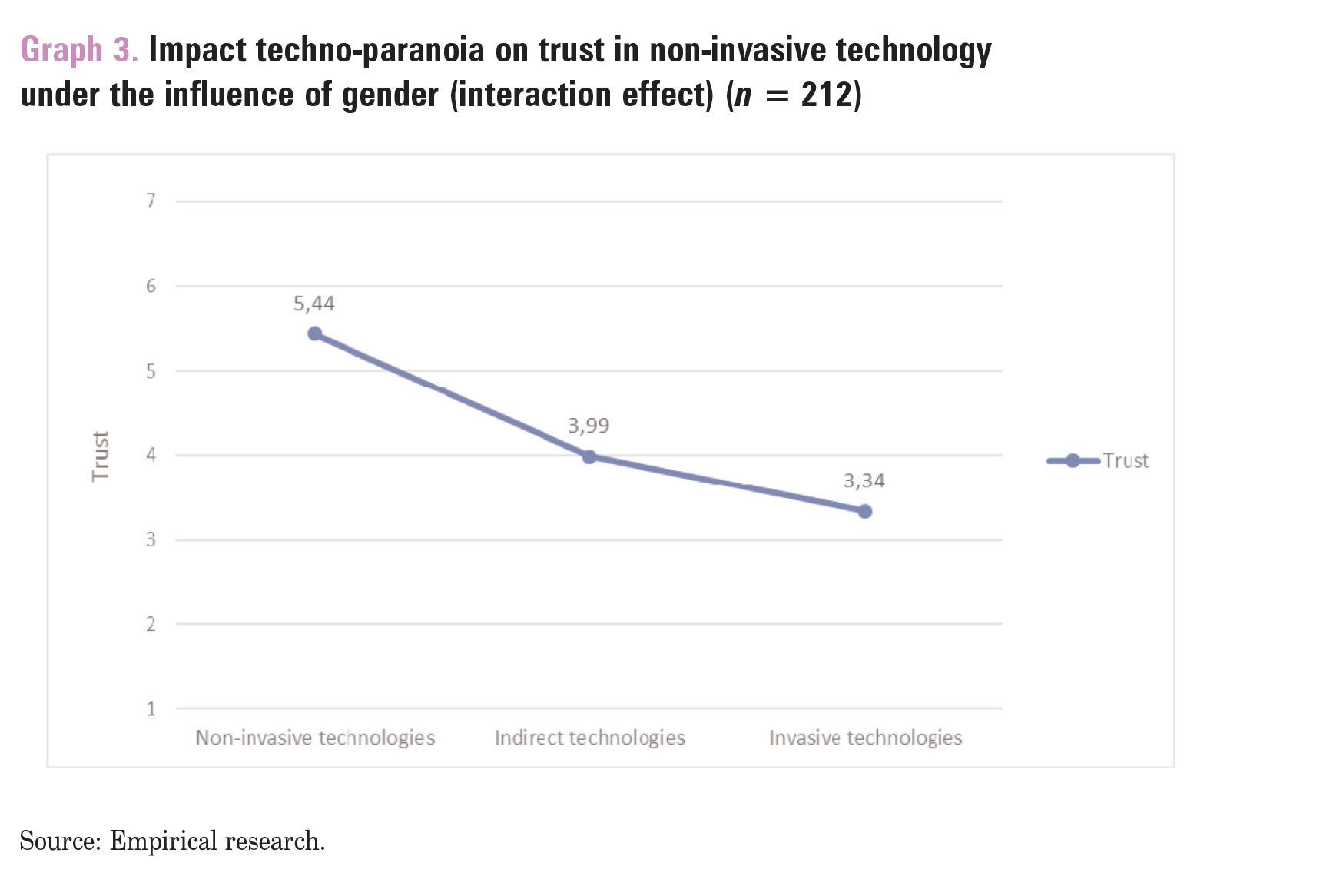
Post hoc tests indicated that (see Graph 3) for men, low levels of technoparanoia were associated with greater trust in non-invasive technologies (b = –0.557, SE = 0.119, t = –4.693, p < 0.001, LLCI = –0.791, ULCI = –0.323). Thus, men with low levels of techno-paranoia indicated greater trust in non-invasive technologies than men with mid- and high levels of technoparanoia. A similar effect was seen in women (b = –0.262, SE = 0.078, t = –3.347, p = 0.001, LLCI = –0.416, ULCI = –0.108). Women with low techno-paranoia had higher levels of trust in non-invasive technologies than women with mid- and high techno-paranoia. It was additionally noted that the decrease in trust when the level of techno-paranoia increased was more dynamic in men than in women. At low levels of techno-paranoia,men have higher levels of trust in technology than women. This situation changes as the level of techno-paranoia increases; at mid-level, trust in technology in men is lower than in women, and the same situation is observed in those with high levels of techno-paranoia. For indirect technologies, no interaction effect was observed between gender and techno-paranoia. Focusing on invasive technologies such as subcutaneous chips, a significant interaction effect was noted between gender and technoparanoia and trust in this type of technology (b = 0.480, SE = 0.188, t = 2.546, p < 0.05, LLCI = 0.108, ULCI = 0.851).
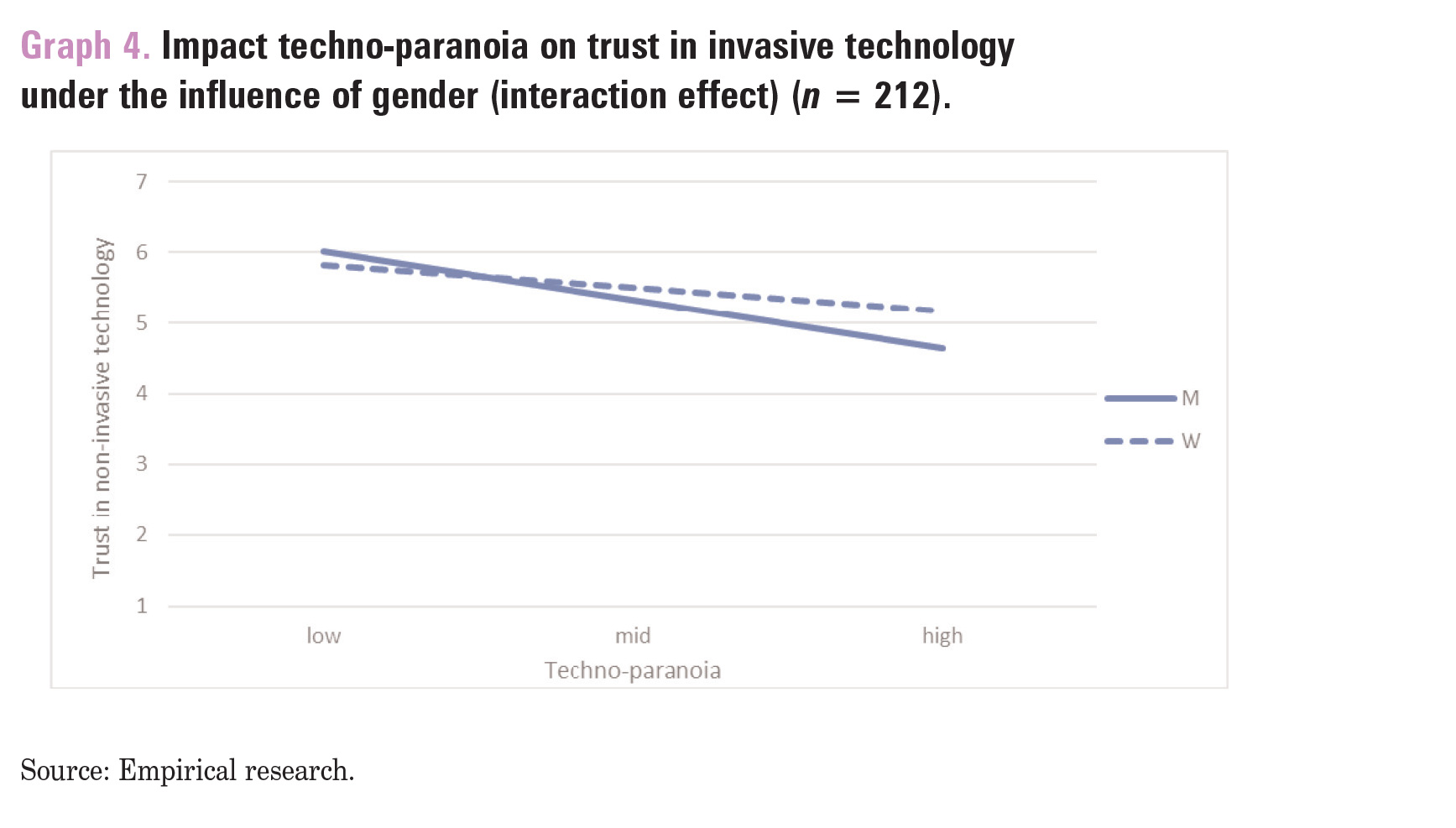
Conducted post hoc tests indicated a similar nature of the relationship that existed for non-invasive technologies. As techno-paranoia increases, the trust in invasive technologies decreases for both men (b = –0.744, SE = 0.157, t = –4.728, p < 0.001, LLCI = –1.054, ULCI = –0.434) and women (b = –0.264, SE = 0.104, t = –2.550, p < 0.05, LLCI = –0.468, ULCI = –0.060). In addition, it can be seen that at low techno-paranoia, men have more trust in invasive technologies than women. However, this situation changes as techno-paranoia increases, and at mid- and high levels, trust in this type of technology is higher in women than in men (see Graph 4).
Discussion and Conclusion
Regarding the formulated research questions for the first one – the level of trust differs significantly for the different types of this technology. The respondents have the highest average trust values, that is, the highest trust, in relation to non-invasive technologies, and the lowest in relation to technologies that invade the human body.
Referring to RQ2, it was found that narcissism did not statistically determine trust in each type of wearables technology. Techno-fear proved to be a significant determinant only for non-invasive technologies (the higher the trust, the lower the techno-fear value). Techno-paranoia, on the other hand, proved to be a statistically significant determinant for trust in each of the technology types tested. The higher the level of trust, the lower the level of techno-paranoia.
The results of the conducted study show that techno-fear and technoparanoia significantly (negatively) determine the level of trust. The reason for this may be that respondents may be afraid of the device itself interfering with the body, losing data security, possible damage to the device inside the body or simply never having used the device. Such a fear effect can be reduced by, for example, providing opportunities for more frequent contact with the technology in question or better education on its use (Agha & Saeed, 2015; Aksoy et al., 2020; Sherrill et al., 2022).
Considering the significant interaction effect of gender and technoparanoia in relation to trust in wearables technology, it can be seen that as concern about technology (techno-paranoia) increases, trust in technology (both invasive and non-invasive) decreases, and this effect is stronger for men than for women. It can also be noted that men and women differ in terms of trust in technology at different levels of techno-paranoia. Higher levels of trust at low levels of techno-paranoia may be explained by the fact that men are generally more technologically advanced than women (Goswami & Dutta, 2015). This situation was the case for both non-invasive and invasive technologies. With regard to the trust variation in the case of increased techno-paranoia, it appears that men are more prone to paranoia and paranoid behavior than women (Millon & Davis, 1996; Sperry, 1996; Von Gemmingen et al., 2003), which may cause men to be more suspicious (Von Gemmingen et al., 2003) of wearables technology, for instance, which in this case may be related to a much greater decrease in trust in this type of technology than in women.
The limitations of the present study are certainly the purposive nature of the sampling and its size, which makes it impossible to generalise the results to the entire general population. It is also worth noting that the group is of similar age. Future research should pay attention to what the trust issue is for the other age groups and whether there are similar relationships in terms of the dependent variables studied. It is also worth investigating whether the moderating effect of gender also occurs in other age groups and considering other demographic and psychographic variables.

References
1. Activate. (2022). Wearables and connected fitness equipment market size in the United States in 2019, 2022, and 2026 (in billion U.S. dollars) [Graph]. In Statista. Retrieved January 25, 2023, from https://www-1statista-1com-10npp4ezi0f0f.han3.lib.uni.lodz.pl/ statistics/1351150/wearables-and-connected-fitness-equipment-market-size-us/
2. Agha, S., & Saeed, M. (2015). Factors influencing customer acceptance of online banking in Pakistan and the moderating effect of technophobia. Technology, 12(1), 55–66.
3. Aksoy, N. C., Alan, A. K., Kabadayi, E. T., & Aksoy, A. (2020). Individuals’ intention to use sports wearables: The moderating role of technophobia. International Journal of Sports Marketing and Sponsorship, 21(2), 225–245. https://doi.org/10.1108/IJSMS-082019-0083
4. Albesher, A. A., & Alhomoud, A. (2020). Determinants towards a better acceptance model of IoT in KSA and eradication of distrust in omnipresent environments. International Journal of Advanced Computer Science and Applications, 11(12), 533–539.
5. Al-Emran, M., Al-Nuaimi, M. N., Arpaci, I., Al-Sharafi, M. A., & Anthony Jnr, B. (2022). Towards a wearable education: Understanding the determinants affecting students’ adoption of wearable technologies using machine learning algorithms. Education and Information Technologies, 28(3), 2727–2746.
6. Askari, S. I., Huldtgren, A., & IJsselsteijn, W. (2018, March). Wear it or fear it: Exploration of drivers & barriers in smartwatch acceptance by senior citizens. In 4th International Conference on Information and Communication Technologies for Ageing Well and e-Health, ICT4AWE 2018 (pp. 26–36). SCITEPRESS-Science and Technology Publications, Lda.
7. Awad, N. F., & Ragowsky, A. (2008). Establishing trust in electronic commerce through online word of mouth: An examination across genders. Journal of Management Information Systems, 24(4), 101–121. https://doi.org/10.2753/MIS0742-1222240404
8. Brown, B. (2020). IDC Forecasts Double-Digit Wearables Growth through 2024, Retrieved January 15, 2023, from https://healthtechinsider.com/2020/10/26/idcforecastsdouble-digit-weables-growth-through-2024/
9. Buffardi, L. E., & Campbell, W. K. (2008). Narcissism and social networking web sites. Personality and Social Psychology Bulletin, 34(10), 1303–1314. https://doi.org/10.
1177/0146167208320061
10. Buimer, H. P., Bittner, M., Kostelijk, T., Geest, T. M., van Wezel, R. J., & Zhao, Y. (2016, July). Enhancing emotion recognition in VIPs with haptic feedback. In International Conference on Human-Computer Interaction (pp. 157–163). Springer, Cham, Germany.
11. Catherwood, P. A., Finlay, D. D., & McLaughlin, J. A. D. (2015, November). Subcutaneous body area networks: A SWOT analysis. In 2015 IEEE International Symposium on Technology and Society (ISTAS) (pp. 1–8). IEEE, Dublin, Ireland.
12. Clusiault, D., Avery, T., Stephens, A., Vigna, C., & Fischer, S. L. (2022). Scoping review on the state of the integration of human physiological responses to evaluating heatstress. Applied Ergonomics, 101, 103704.
13. Fang, Y., Qureshi, I., Sun, H., McCole, P., Ramsey, E., & Lim, K. H. (2014). Trust, satisfaction, and online repurchase intention: The moderating role of perceived effectiveness of E-commerce institutional mechanisms. Mis Quarterly, 38(2), 407–427.
https://doi.org/10.25300/MISQ/2014/38.2.04
14. Gao, S., Zhang, X., & Peng, S. (2016, September). Understanding the adoption of smart wearable devices to assist healthcare in China. In Conference on e-Business, e-Services and e-Society (pp. 280–291). Springer, Cham, Germany.
15. Gefen, D., Karahanna, E., & Straub, D. W. (2003). Trust and Tam in online shopping: An integrated model. MIS Quarterly, 27(1), 51–90. https://doi.org/10.2307/30036519
16. George, D. (2011). SPSS for windows step by step: A simple study guide and reference, 17.0 update, 10/e. Pearson Education India.
17. Gong, X., Lee, M. K., & Liu, Z. (2015). Understanding the effect of Tie strength on continuance intention of second-generation mobile instant messaging services. In The 19th Pacific Asia Conference on Information Systems, Singapore, Asia, 1–15.
18. Goswami, A., & Dutta, S. (2015). Gender differences in technology usage – A literature review. Open Journal of Business and Management, 4(1), 51–59. https://doi.org/ 10.4236/ojbm.2016.41006
19. GUS. (2020). Share of people with general digital skills in Poland in 2020, by skill level and age group [Graph]. In Statista. Retrieved January 15, 2023, from https://www1statista-1com-10npp4eqh02c8.han3.lib.uni.lodz.pl/statistics/1136309/poland-share-ofpoleswith-general-digital-skills-in-poland-by-level-and-age/
20. Hayes, A. (2022). Introduction to mediation, moderation, and conditional process analysis: A regression-based approach. The Guilford Press.
21. Karahanoglu, A., & Erbug, Ç. (2011, June). Perceived qualities of smart wearables: Determinants of user acceptance. In Proceedings of the 2011 Conference on Designing Pleasurable Products and Interfaces (pp. 1–8). Association for Computing Machinery, New York, USA.
22. Khasawneh, O. Y. (2018). Technophobia without boarders: The influence of technophobia and emotional intelligence on technology acceptance and the moderating influence of organizational climate. Computers in Human Behavior, 88, 210–218.
https://doi.org/10.1016/j.techsoc.2018.03.008
23. Kräuter, N., Lösing, S., Bauer, G., Schwering, L., & Seuter, M. (2016, September). Supporting safety in cycling groups using LED-augmented gestures. In Proceedings of the 2016 ACM International Joint Conference on Pervasive and Ubiquitous Computing: Adjunct (pp. 889–892). https://doi.org/10.1145/2968219.2968573
24. Lachowicz-Tabaczek, K., & Kozłowska, M. A. (2021). Being others-oriented during the pandemic: Individual differences in the sense of responsibility for collective health as a robust predictor of compliance with the COVID-19 containing measures. Personality and Individual Differences, 183, 111138. https://doi.org/10.1016/j.paid.2021.111138
25. Lee, W.H., Lin, C.W., & Shih, K.H., 2018. A technology acceptance model for the perception of restaurant service robots for trust, interactivity, and output quality. International Journal of Mobile Communications, 16(4), 361–376. https://doi.org/ 10.1504/ IJMC.2018.092666
26. Lim, H., Kim, B., & Park, S. (2019). Prediction of lower limb kinetics and kinematics during walking by a single IMU on the lower back using machine learning. Sensors, 20(1), 130.
27. Mencarini, E., Leonardi, C., De Angeli, A., & Zancanaro, M. (2016, October). Design opportunities for wearable devices in learning to climb. In Proceedings of the 9th Nordic Conference on Human-Computer Interaction (pp. 1–10). Association for Computing Machinery, New York, USA.
28. Millon, T., & Davis, R. (1996). Disorders of personality DSM-IV and beyond. Wiley.
29. Nascimento, B., Oliveira, T., & Tam, C. (2018). Wearable technology: What explains continuance intention in smartwatches? Journal of Retailing and Consumer Services, 43, 157–169. https://doi.org/10.1016/j.jretconser.2018.03.017
30. Ortiz, J. S., Velasco, P. M., Quevedo, W. X., Álvarez, V. M., Sánchez, J. S., Carvajal, C. P., Cepeda, L. P., & Andaluz, V. H. (2017, June). Realism in audiovisual stimuli for phobias treatments through virtual environments. In International Conference on Augmented Reality, Virtual Reality and Computer Graphics (pp. 188–201). Springer, Cham, Germany.
31. Pancar, T., & Ozkan Yildirim, S. (2021). Exploring factors affecting consumers’ adoption of wearable devices to track health data. Universal Access in the Information Society, 22, 331–349.
32. Pavlou, P.A., & Gefen, D. (2004). Building effective online marketplaces with institution-based trust. Information Systems Research, 15(1), pp. 37–59. https://doi.org/ 10.1287/isre.1040.0015
33. Pearson, C., & Hussain, Z. (2015). Smartphone use, addiction, narcissism, and personality: A mixed methods investigation. International Journal of Cyber Behavior, Psychology and Learning, 5(1), 17–32. https://doi.org/10.4018/ijcbpl.2015010102
34. Pengnate, S. F., & Sarathy, R. (2017). An experimental investigation of the influence of website emotional design features on trust in unfamiliar online vendors. Computers in Human Behavior, 67, 49–60. https://doi.org/10.1016/j.chb.2016.10.018
35. Piątek, Z. (2018). Wearables, czyli elektronika noszona. https://przemysl-40.pl/ index.php/2018/12/11/wearables-czyli-elektronika-noszona/ (dostęp na dzień: 15.01.2023).
36. Reuters. (2022). Factbox: Neuralink: What you need to know about Elon Musk’s brain chip company. Retrieved January 15, 2023, from https://www.reuters.com/technology/whatdoeselon-musks-brain-chip-company-neuralink-do-2022-12-05/
37. Ridings, C. M., Gefen, D., & Arinze, B. (2002). Some antecedents and effects of trust in virtual communities. The Journal of Strategic Information Systems, 11(3), 271–295. https://doi.org/10.1016/S0963-8687(02)00021-5
38. Riedl, R., Hubert, M., & Kenning, P. (2010). Are there neural gender differences in online trust? An FMRI study on the perceived trustworthiness of eBay offers. MIS Quarterly, 34(2), 397–428. https://doi.org/10.2307/20721434
39. Rosen, L. D., Whaling, K., Rab, S., Carrier, L., & Cheever, N. (2013). Is Facebook Creating iDisorders? The link between clinical symptoms of psychiatric disorders and technology use, attitudes and anxiety. Computers in Human Behavior, 29(3), 1243–1254.
https://doi.org/10.1016/j.chb.2012.11.012
40. Sagan, A. (2004). Badania marketingowe. Podstawowe kierunki. Wydawnictwo Akademii Ekonomicznej w Krakowie.
41. Saliba, B., Spiteri, J., & Cortis, D. (2021). Insurance and wearables as tools in managing risk in sports: Determinants of technology take-up and propensity to insure and share data. The Geneva Papers on Risk and Insurance-Issues and Practice, 47, 499–519.
42. Schamberger, A., & Nieroda, M. (2017). Exploring usefulness of well-being wearables for improved adoption (qualitative approach: An abstract). In: Stieler, M. (ed) Creating marketing magic and innovative future marketing trends (pp. 323–324). Springer, Cham.
https://doi.org/10.1007/978-3-319-45596-9_63
43. Shao, Z., Guo, Y., Li, X., & Barnes, S. (2020). Sources of influences on customers’ trust in ride-sharing: Why use experience matters? Industrial Management & Data Systems, 120(8), 1459–1482. https://doi.org/10.1108/IMDS-12-2019-0651
44. Sherrill, A. M., Wiese, C. W., Abdullah, S., & Arriaga, R. I. (2022). Overcoming clinician technophobia: What we learned from our mass exposure to telehealth during the COVID-19 pandemic. Journal of Technology in Behavioral Science, 7(4), 547–553.
https://doi.org/10.1007/s41347-022-00273-3
45. Sperry, L. (1996). Handbook of diagnosis and treatment of the DSM-IV personality disorders. Brunner & Mazel.
46. Sułkowski, Ł., & Kaczorowska-Spychalska, D. (2021). Determinants of the adoption of AI wearables-practical implications for marketing. Human Technology, 17(3), 294–320.
47. The Economist. (2018). Why Swedes are inserting microchips into their bodies. No more worries about losing your wallet-but plenty about privacy, https://www.economist.com/ europe/2018/08/02/why-swedes-are-inserting-microchips-into-their-bodies, (dostęp na dzień 15.01.2023).
48. The Economist. (2022). Wearable devices measure a growing array of health indicators. They can detect a disease before it develops, https://www.economist.com/technology-quarterly/2022/05/02/wearable-devices-measure-a-growing-array-of-health-indicators, (dostęp na dzień 15.01.2023).
49. The Times of India. (2020). 16 sensors that are present inside fitness bands and smartwatches that you need to know, http://timesofindia.indiatimes.com/articleshow/ 78033264.cms?utm_source=contentofinterest&utm_medium=text&utm_campaign=cppst, (dostep na dzień 15.01.2023).
50. Viegas, C., Lau, S. H., Maxion, R., & Hauptmann, A. (2018, September). Towards independent stress detection: A dependent model using facial action units. In 2018 International Conference on Content-Based Multimedia Indexing (CBMI) (pp. 1–6). IEEE, La Rochelle, France.
51. Von Gemmingen, M. J., Sullivan, B. F., & Pomerantz, A. M. (2003). Investigating the relationships between boredom proneness, paranoia, and self-consciousness. Personality and Individual Differences, 34(6), 907–919. https://doi.org/10.1016/S0191-8869 (01)00219-7
52. Wild, F., Klemke, R., Lefrere, P., Fominykh, M., & Kuula, T. (2017, June). Technology acceptance of augmented reality and wearable technologies. In International Conference on Immersive Learning (pp. 129–141). Springer, Cham, Germany. https://doi.org/ 10.1007/978-3-319-60633-0_11
53. Wright, R., & Keith, L. (2014). Wearable technology: If the tech fits, wear it. Journal of Electronic Resources in Medical Libraries, 11(4), 204–216.
54. Wu, J. J., Chen, Y. H., & Chung, Y. S. (2010). Trust factors influencing virtual community members: A study of transaction communities. Journal of Business Research, 63(9), 1025–1032. https://doi.org/10.1016/j.jbusres.2009.03.022
Bogdan Gregor — Full Professor in the Department of Marketing at the University of Lodz. His main research interests include marketing, especially the evolution of marketing concepts, marketing in the digital era and marketing research. His scientific achievements involve over 400 papers, among them 26 books (published in Poland and abroad). He is a Scholar of the Humboldt Foundation and DAAD and Visiting Professor at universities in the USA, Germany, Spain and Holland.
Emilian Gwiaździński — PhD, working at the subdepartment of Marketing Research, Department of Marketing, Faculty of Management, University of Łódź. His research interests focus on the transformation of the digital economy, digital technologies, wearables, the ecosystem of the Internet of things, artificial intelligence, digital marketing, a new type of consumer in the market and new market opportunities.

